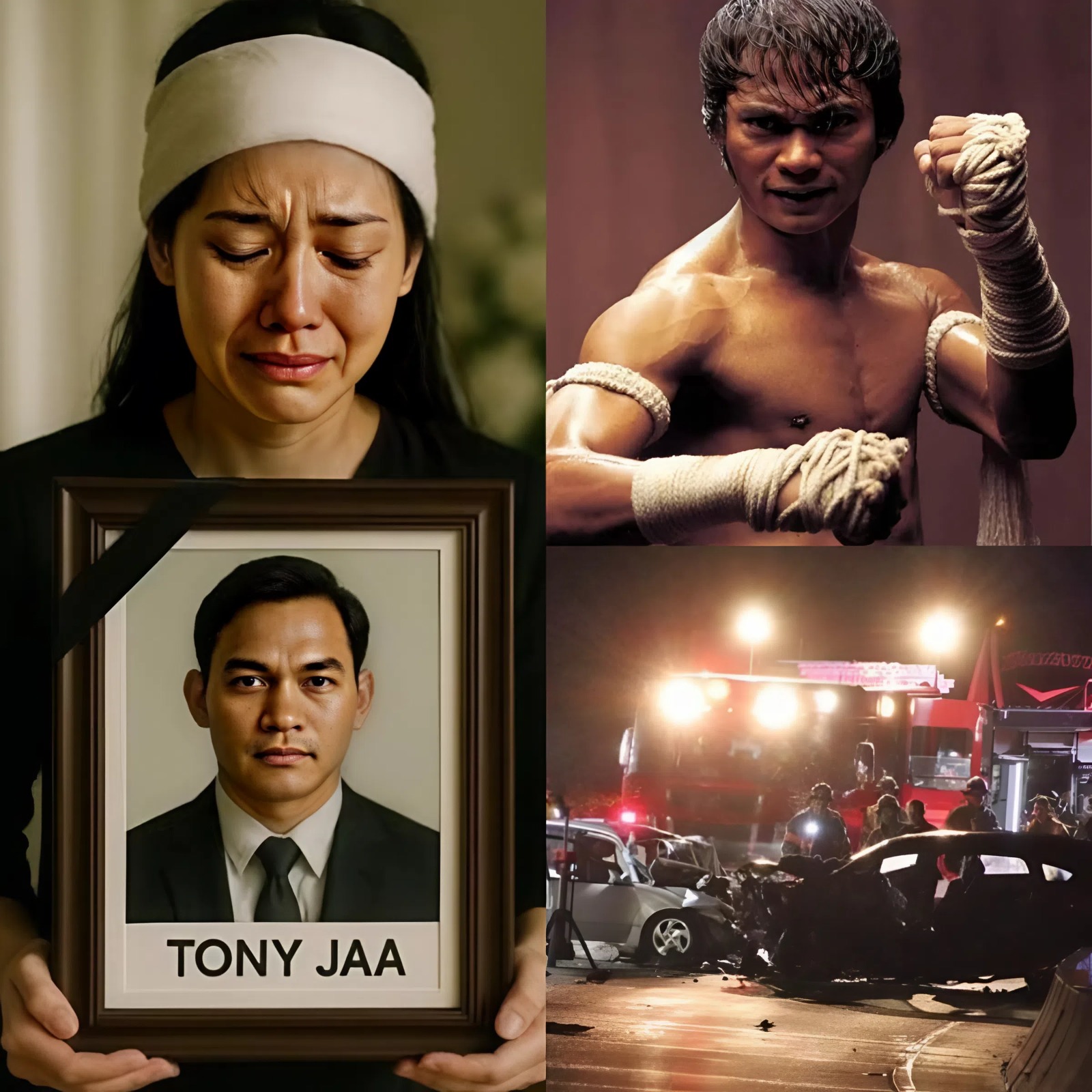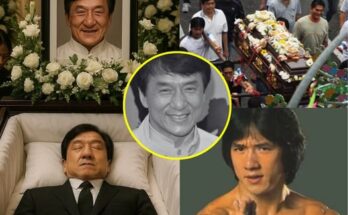The streets of Bangkok stood still as news spread like wildfire—Tony Jaa, the martial arts legend whose fists once shook cinema screens, had taken his final bow…
Just hours before, witnesses say he was full of life, training with the same intensity that made him a global icon. But in a moment that no one saw coming, silence replaced the sound of his strikes. Emergency sirens wailed through the night as fans gathered outside the hospital, praying for a miracle that never came. Across the world, tributes now flood in, each one echoing the same disbelief: how could a warrior so strong fall so suddenly? His final scene has left the world in tears — and questions linger in the shadows he left behind…
When the morning sun rose over Bangkok that day, it illuminated a city changed forever. The usual buzz of motorbikes, street vendors, and chatter fell into a strange quiet. From the alleyways of Chatuchak to the shimmering towers of Sukhumvit, people paused mid-step, staring at their phones, unable to believe what they were reading. Tony Jaa, the man who had once carried Thailand’s fighting spirit into the global spotlight — the silent warrior whose fists told stories words could not — was gone.
For decades, his name had been synonymous with unflinching strength, discipline, and cultural pride. But his passing was more than the loss of a movie star — it was the fading of an era when martial arts was not choreography, but truth; when action on screen still drew blood, sweat, and tears.
From the Rice Fields to the Silver Screen
Tony Jaa’s story has always bordered on myth. Born Panom Yeerum in the northeastern province of Surin, he grew up in a modest farming family. His earliest “training ground” was not a dojo or a gym, but the rice fields and forests of his village. He would leap from tree to tree, dive into rivers, and practice kicks against the trunks of banana trees. There were no trainers, no protective mats — just pure instinct and imagination.

He idolized Bruce Lee, Jackie Chan, and Jet Li, not for their fame but for their devotion. “When I saw Enter the Dragon, I didn’t just see fighting,” he once said in an early interview. “I saw art — I saw a way of life.”
That devotion caught the attention of Panna Rittikrai, the legendary Thai stunt coordinator known for his brutal realism. Under Panna’s mentorship, Tony underwent years of punishing physical training that bordered on asceticism. He would run on sand dunes for hours, practice jumps until his legs gave out, and perform stunts that left him bloodied but unbroken.
By the time Ong-Bak: Muay Thai Warrior hit theaters in 2003, the world had never seen anything like it. There were no camera tricks, no safety wires — only Tony Jaa and gravity, locked in a contest he almost always won. His elbows and knees cracked through glass and bone alike, each movement an homage to traditional Muay Boran, the ancient predecessor of Muay Thai.
Critics called it a revelation. Time Magazine described him as “the most authentic martial artist of his generation.” Quentin Tarantino declared, “Ong-Bak is pure adrenaline. Tony Jaa doesn’t act — he detonates.”
The Philosophy Behind the Fury
To understand Tony Jaa’s appeal, one must look beyond the spectacular violence. Beneath the high kicks and bone-breaking sequences was a spiritual discipline rooted deeply in Thai Buddhist philosophy.
“Every strike must come from stillness,” he often said. “If the mind is not calm, the body will betray you.”
Unlike many action stars who treated martial arts as performance, Jaa treated it as a form of meditation — a conversation between body, spirit, and purpose. His movements were deliberate, his silence profound. Even in interviews, he spoke little. When he did, it was with a calm that mirrored a monk’s restraint.
:max_bytes(150000):strip_icc()/GettyImages-632972664-592048395f9b58f4c090a21c.jpg)
That philosophy wasn’t just aesthetic; it was personal. In 2010, at the height of his fame, Tony shocked the world by leaving the film industry to become a Buddhist monk. No press conference, no farewell tour — just a quiet disappearance into the saffron robes of temple life.
“He wanted peace,” said one of his closest friends. “He said fame had made his spirit noisy.”
During his time in the temple, Jaa would rise at dawn, meditate for hours, and live on alms from the community. To outsiders, it seemed like madness — a superstar walking away from wealth and power. But for Tony, it was the only way to return to himself.
A Star Torn Between Worlds
After leaving the monastery, Tony Jaa returned to filmmaking — but the industry had changed. Hollywood came calling, eager to cast him in blockbuster franchises like Fast & Furious and xXx: Return of Xander Cage. Yet despite the glamour, there was an unmistakable disconnect.
In those roles, he was often reduced to the “silent exotic fighter,” stripped of the emotional and spiritual depth that defined his earlier work. “They wanted the moves, not the meaning,” one Thai critic wrote. “Hollywood took the fists and left the soul behind.”
Tony knew it too. Though he fulfilled his obligations with professionalism, he longed to return to the authenticity that birthed him. He began producing smaller films in Thailand, collaborating with local directors and choreographers to revive the purity of old-school stunt work. But the industry was now dominated by digital effects, drones, and green screens.
It wasn’t the same.
And yet, he never complained. He simply worked harder, training new generations of stunt performers, emphasizing that honor, humility, and respect were as vital as technique. “If you do not fight with respect,” he told his students, “you have already lost.”
The Final Battle
Reports suggest that Tony had been quietly battling a long-term illness for nearly a year. True to his nature, he told few people — not even some of his closest collaborators. “He didn’t want pity,” a family member shared. “He said the body is temporary, but the work remains.”

His final public appearance came during a Muay Thai heritage event in Ayutthaya earlier this year. Thin but smiling, he performed a traditional Wai Kru — the ritual dance fighters perform before a match — to honor teachers and ancestors. When he bowed at the end, thousands in attendance bowed back, unaware it would be his last.
The announcement of his death sent shockwaves across the nation. Thailand’s Prime Minister declared a national day of remembrance, calling him “a man who showed the world the soul of Thai courage.”
Across social media, tributes poured in from around the world. Donnie Yen wrote:
“Tony Jaa was more than a fighter. He was a bridge between worlds — the ancient and the modern, East and West, body and spirit.”
The Cultural Earthquake He Left Behind
Tony Jaa’s legacy transcends cinema. He revived pride in Thai identity at a time when many young people felt disconnected from tradition. Through him, Muay Thai became more than sport — it became symbol, philosophy, language.
His films were also political in their own quiet way. In Ong-Bak, when he refused to let sacred relics be stolen and sold abroad, audiences saw not just a hero, but a man defending his culture from commodification. It was Thailand standing against exploitation — fists first, pride intact.
He represented the strength of the ordinary Thai — the farmer, the monk, the fighter. His message was simple: greatness doesn’t come from privilege, but from perseverance.
An Eternal Flame
As the streets of Bangkok flickered with candlelight vigils, and fans projected his film scenes onto temple walls, one couldn’t help but feel the circular poetry of his life — a boy who dreamed of martial heroes becoming one himself, only to leave the world with the serenity of a monk.
He lived with the same discipline he fought with. And perhaps that’s the lesson Tony Jaa leaves behind: true strength is quiet, born not in defiance but in devotion.

In one of his final interviews, he said something that now feels prophetic:
“When I die, don’t remember my stunts. Remember my silence before them — that is where my power came from.”
The streets of Bangkok are noisy again now. Life moves on, as it always does. But somewhere, in a village under the red Thai sun, a young boy is watching Ong-Bak for the first time — and dreaming of the impossible.
And that’s how legends never truly die.



